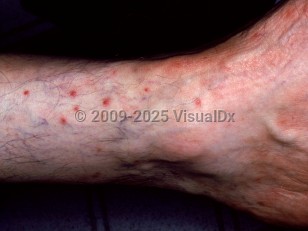Chigger bite in Child
Alerts and Notices
Important News & Links
Synopsis

Chigger is the common name for the larval form of the trombiculid mite. Other names for the mite are harvest bugs, harvest lice, harvest mites, jiggers, and red bugs. Chigger bites occur maximally during summer through early autumn. This season also correlates with their maximal breeding season, as these mites reproduce in large populations during warm, rainy days, and their habitat of weeds, grasses, and undergrowth is the most abundant during this time.
Chigger infestation is caused by the mite larvae. Mites lay their eggs on leaves and tall grasses, and when the larva hatches from the egg, it begins its search for a host. Chiggers are parasites that attach to a variety of hosts, such as birds, reptiles, and small mammals as well as humans. The larvae do not penetrate the skin but remain attached by inserting their piercing mouthparts. They feed by injecting digestive enzymes into the bite wound and then sucking up the digested tissue fluid. The digestive enzymes secreted by the mite larvae triggers the immune response in the host to produce the intensely pruritic "chigger bite."
Pruritus does not begin until 3-24 hours later, and papules may persist for up to 3 weeks. Mites are red and so small that even after biting, they are barely visible to the human eye. Chiggers do not stay attached for long and fall off or die within hours. The itching may last for several days after the chigger is killed or drops off. The number of new eruptions may increase for 2 days.
Chiggers are widely distributed throughout the world. In the United States, they are located in the southeastern and south central states. Chiggers are important vectors of scrub typhus in Asia. Chiggers can also serve as vectors of viral hemorrhagic fever and hantavirus.
Summer penile syndrome is seasonal penile swelling that occurs in children, typically in the summer months of June through September. It represents a hypersensitivity response to chigger bites.
Chigger infestation is caused by the mite larvae. Mites lay their eggs on leaves and tall grasses, and when the larva hatches from the egg, it begins its search for a host. Chiggers are parasites that attach to a variety of hosts, such as birds, reptiles, and small mammals as well as humans. The larvae do not penetrate the skin but remain attached by inserting their piercing mouthparts. They feed by injecting digestive enzymes into the bite wound and then sucking up the digested tissue fluid. The digestive enzymes secreted by the mite larvae triggers the immune response in the host to produce the intensely pruritic "chigger bite."
Pruritus does not begin until 3-24 hours later, and papules may persist for up to 3 weeks. Mites are red and so small that even after biting, they are barely visible to the human eye. Chiggers do not stay attached for long and fall off or die within hours. The itching may last for several days after the chigger is killed or drops off. The number of new eruptions may increase for 2 days.
Chiggers are widely distributed throughout the world. In the United States, they are located in the southeastern and south central states. Chiggers are important vectors of scrub typhus in Asia. Chiggers can also serve as vectors of viral hemorrhagic fever and hantavirus.
Summer penile syndrome is seasonal penile swelling that occurs in children, typically in the summer months of June through September. It represents a hypersensitivity response to chigger bites.
Codes
ICD10CM:
B88.0 – Other acariasis
SNOMEDCT:
402157004 – Dermatosis due to harvest mite
B88.0 – Other acariasis
SNOMEDCT:
402157004 – Dermatosis due to harvest mite
Look For
Subscription Required
Diagnostic Pearls
Subscription Required
Differential Diagnosis & Pitfalls

To perform a comparison, select diagnoses from the classic differential
Subscription Required
Best Tests
Subscription Required
Management Pearls
Subscription Required
Therapy
Subscription Required
References
Subscription Required
Last Updated:09/10/2017
 Patient Information for Chigger bite in Child
Patient Information for Chigger bite in Child
Premium Feature
VisualDx Patient Handouts
Available in the Elite package
- Improve treatment compliance
- Reduce after-hours questions
- Increase patient engagement and satisfaction
- Written in clear, easy-to-understand language. No confusing jargon.
- Available in English and Spanish
- Print out or email directly to your patient
Upgrade Today

Chigger bite in Child

